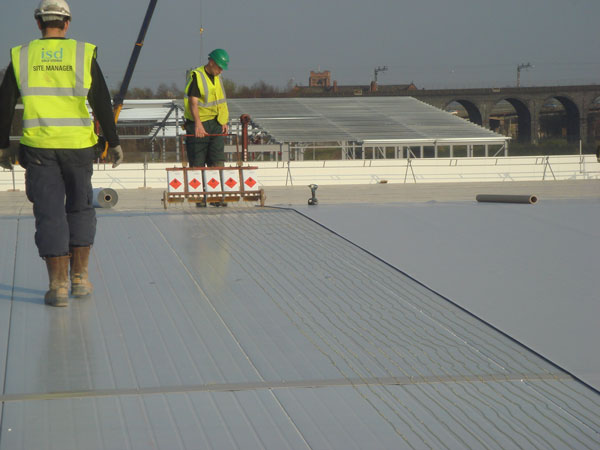What you should look out for when considering a green roof and how to maximise success.
By Mike Goodhead, Divisional Manager for ISD Solution’s new industrial waterproofing division.
Green roofs have come a long way as genuine construction options. Understanding of how they work plus training and installation expertise means that failures are now very rare. Technical advances and quality of the materials used has also contributed.
Nevertheless, green roofs, and derivative brown and blue roof solutions, remain a complex area and there are plenty of issues to consider for a risk free and enduring solution. Indeed, opinions still vary enormously and there are no hard and fast rules.
Poor design and the wrong waterproofing membrane for the chosen application, combined with a sometimes cavalier attitude to additional penetrations through the roof structure, were common mistakes, as was bad or insufficient irrigation.
There is a significant difference between a green roof that fails because it cannot sustain the desired vegetation cover and one that leaks, compromising the building below. Both can be rectified; but tracing and repairing a leak, or replacing a failed waterproof layer, will be a far more complex and costly exercise.
Today green roofs can be designed to meet a wide variety of commercial requirements and generally fall into three categories – Extensive, Semi-Intensive and Intensive. Each has a progressively deeper growing medium, up to a metre in depth for Intensive types, with differing maintenance and irrigation requirements.
These in turn have different weight and structural considerations and require different roofing solutions. The waterproof membrane is critical here, and there are a wide range of products available covering the latest liquid applied systems, hot melt, mastic asphalt and numerous built up systems. And each has different application requirements.
Get expert input
On top goes the root barrier, insulation, drainage layer, particle barriers, the growing medium followed by the planting scheme. With so many variables each influenced by different factors, from the structure of the roof deck and depth of the growing medium, to prevailing weather and storm water management, expert input to select the right solution is essential.
Design out issues
A key step to minimising risk is to engage with the installation contractor, and where necessary the roof system manufacturer, at the earliest stages of a project, before construction commences. On new builds this may have to wait until the main contractor is appointed, but the earlier the better. In this way the project benefits from expert input as the design is developed. It also affords full understanding of the roof structure, drainage, penetrations, upstands, parapets and plant, so that an appropriate waterproofing design can be developed and potential issues can be identified and plans modified.
Communicate changes
Invariably design changes occur once on site and good change control procedures must be followed. This ensures that roofing contractors are party to new detailing and openings which may affect the proposed waterproofing scheme. This factor is frequently overlooked and is a cause of concern if not monitored closely.
The right contractor
When selecting a contractor look for an appropriate track record, but also expertise at the design stage. Evidence of proper training (many waterproofing products still require skilled hand application), product knowledge, the depth of relationships with manufacturing partners, contractor checks and guarantees, should all be examined. ISD Solutions puts strong emphasis on all these factors, and we are always pleased to provide examples.
Double test
Once the roof slab is cast, the waterproof membrane can be applied, ensuring that internal trades can proceed as early as possible. Electronic testing to check the integrity of the membrane is next. Any earths will signify a potential leak and remedial actions can be taken. Competent contractors will conduct this phase as a matter of course; nevertheless, site managers should check that comprehensive testing is conducted properly. Repeat testing, once follow on trades are complete and prior to the build-up of subsequent planting layers and finishes, will ensure a fault free installation.
Protect your investment
The waterproof layer is at its most vulnerable when it has just been laid and where follow on trades are still active. In London, especially where construction space is restricted to the footprint of the building, a new flat roof is all too tempting for storing construction materials and these are literally craned up by the pallet load. Remember, the membrane may only be a few millimetres thick, so it is easy to tear up, puncture or rip, hence the double test procedure described. Effective site management limits accidental damage, but we prefer not to take chances and advocate rubber mats and 20mm ply to provide a temporary protective covering until the final built up layers can proceed.
With planting finished, it is crucial that access is restricted and irrigation is continued until the roof takes properly or until the point of handover when appropriate guidance on irrigation and maintenance should also be detailed. A twelve month follow up visit, something that should be included as standard, will help to pinpoint issues and any maintenance shortcomings.
For more information: www.isd-solutions.co.uk


